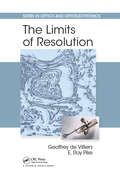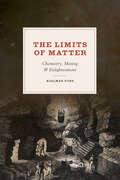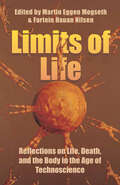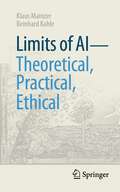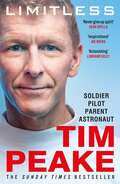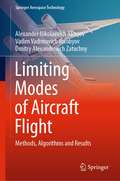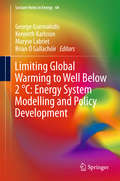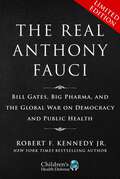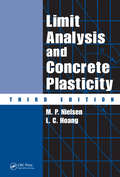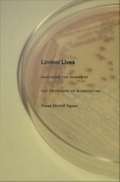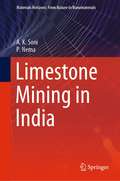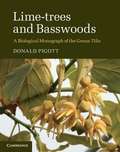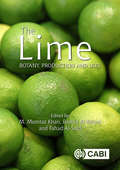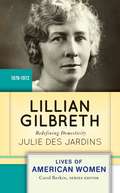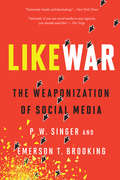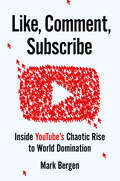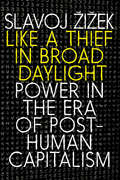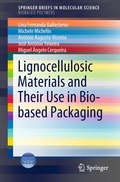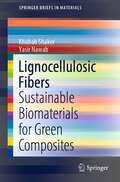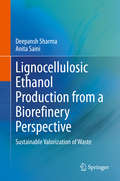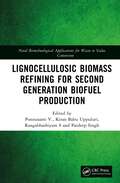- Table View
- List View
The Limits of Resolution (Series in Optics and Optoelectronics)
by Geoffrey de Villiers E. Roy Pike"This beautiful book can be read as a novel presenting carefully our quest to get more and more information from our observations and measurements. Its authors are particularly good at relating it." --Pierre C. Sabatier "This is a unique text - a labor of love pulling together for the first time the remarkably large array of mathematical and statistical techniques used for analysis of resolution in many systems of importance today – optical, acoustical, radar, etc…. I believe it will find widespread use and value." --Dr. Robert G.W. Brown, Chief Executive Officer, American Institute of Physics "The mix of physics and mathematics is a unique feature of this book which can be basic not only for PhD students but also for researchers in the area of computational imaging." --Mario Bertero, Professor, University of Geneva "a tour-de-force covering aspects of history, mathematical theory and practical applications. The authors provide a penetrating insight into the often confused topic of resolution and in doing offer a unifying approach to the subject that is applicable not only to traditional optical systems but also modern day, computer-based systems such as radar and RF communications." --Prof. Ian Proudler, Loughborough University "a ‘must have’ for anyone interested in imaging and the spatial resolution of images. This book provides detailed and very readable account of resolution in imaging and organizes the recent history of the subject in excellent fashion.… I strongly recommend it." --Michael A. Fiddy, Professor, University of North Carolina at Charlotte This book brings together the concept of resolution, which limits what we can determine about our physical world, with the theory of linear inverse problems, emphasizing practical applications. The book focuses on methods for solving illposed problems that do not have unique stable solutions. After introducing basic concepts, the contents address problems with "continuous" data in detail before turning to cases of discrete data sets. As one of the unifying principles of the text, the authors explain how non-uniqueness is a feature of measurement problems in science where precision and resolution is essentially always limited by some kind of noise.
The Limits of Matter: Chemistry, Mining, and Enlightenment
by Hjalmar ForsBy studying the chemists at the Swedish Bureau of Mines and their networks, and integrating their practices into the wider European context, the author illustrates how they and their successors played a significant role in the development of our modern notion of matter and made a significant contribution to the modern European view of reality.
Limits of Life: Reflections on Life, Death, and the Body in the Age of Technoscience
by Martin Eggen Mogseth & Fartein Hauan NilsenNew technologies and scientific imagination rearrange the boundary that we identify as the beginning and end of life. New techno-social constellations, such as the ever-increasing presence of digital avatars and genetic screenings, implore us to reconsider and transcend the existing definitions of life and death. Through a multidisciplinary approach, this volume explores how the limitations and perceived finality of life and death are reconstituted through engagements with modern technology.
Limits of AI - theoretical, practical, ethical (Technik im Fokus)
by Klaus Mainzer Reinhard KahleArtificial intelligence is a key technology with great expectations in science, industry, and everyday life. This book discusses both the perspectives and the limitations of this technology. This concerns the practical, theoretical, and conceptual challenges that AI has to face. In an early phase of symbolic AI, AI focused on formal programs (e.g., expert systems), in which rule-based knowledge was processed with the help of symbolic logic. Today, AI is dominated by statistics-based machine learning methods and Big Data. While this sub-symbolic AI is extremely successful (e.g., chatbots like ChatGPT), it is often not transparent. The book argues for explainable and reliable AI, in which the logical and mathematical foundations of AI-algorithms become understandable and verifiable.
Limitless: The bestselling story of Britain’s inspirational astronaut
by Tim PeakeThe inspirational autobiography of Britain’s beloved astronaut Tim Peake, the #1 bestselling author of Hello, is this Planet Earth? and Ask an AstronautAs heard on BBC Radio 4 Desert Island Discs__________________'What surprised me was how entirely serene I felt. I was weightless, no forces exerting themselves on my body. To my left was the Space Station. Below me, gradually going into shadow, was the Earth. And over my right shoulder was the universe.'In fascinating and personal detail, and drawing on exclusive diaries and audio recordings from his mission, astronaut Tim Peake takes readers closer than ever before to experience what life in space is really like: the sights, the smells, the fear, the sacrifice, the exhilaration and the deep and abiding wonder of the view.Warm, inspiring and often funny, Tim also charts his surprising road to becoming an astronaut, from a shy and unassuming boy from Chichester who had a passion for flight, to a young British Army officer, Apache helicopter pilot, flight instructor and test pilot who served around the world. Tim's extensive eighteen-year career in the Army included the command of a platoon of soldiers in Northern Ireland during the Troubles, deployment in Bosnia, and operations in Afghanistan.Full of life lessons for readers of all ages, Limitless is the story of how ordinary can become extraordinary.__________________'For someone who has literally been out of this world Tim's an incredibly down to earth guy and I think you'll be amazed at some of the things he has done ... it's so inspiring to know that even going into space didn't change him as much as being a parent did.' JOE WICKS'Tim is one of our nation's good guys - and his story is a testament to his courage, kindness and a never-give-up spirit.' BEAR GRYLLS'Full of courage, camaraderie and daring escapades, this reads like a Boys' Own adventure' MIRROR'A fantastic book' PIERS MORGAN'Fasten your seatbelt for an exhilarating read ... His accounts of blasting into orbit at 25 times the speed of sound and floating, weightless, around the space station are enthralling.' EXPRESSBestseller in the UK, Sunday Times, October 2020
Limiting Modes of Aircraft Flight: Methods, Algorithms and Results (Springer Aerospace Technology)
by Alexander Nikolaevich Akimov Vadim Vadimovich Vorobyov Dmitry Alexandrovich ZatuchnyThis book describes in detail a method of direct optimization, which makes it possible to choose the best trajectory of an aircraft in conditions of its limited resource. This can happen in the event of an emergency on board, associated with both a possible equipment failure and external influences, for example, when lightning strikes an aircraft or collides with a moving object. The highlight of this book is the fact that the results presented in it can be applied universally to the choice of the flight path of large and small aircraft, as well as helicopter technology. In addition, they take into account various conditions of aircraft flight, including a possible accident. The methods and algorithms presented here can be used as the basis for the creation of automatic collision avoidance systems, as well as the choice of the best aircraft trajectory for flights in different regions and in different conditions.
Limiting Global Warming to Well Below 2 °C: Energy System Modelling and Policy Development (Lecture Notes In Energy #64)
by George Giannakidis Kenneth Karlsson Maryse Labriet B. Ó GallachóirThis book presents the energy system roadmaps necessary to limit global temperature increase to below 2°C, in order to avoid the catastrophic impacts of climate change. It provides a unique perspective on and critical understanding of the feasibility of a well-below-2°C world by exploring energy system pathways, technology innovations, behaviour change and the macro-economic impacts of achieving carbon neutrality by mid-century. The transformative changes in the energy transition are explored using energy systems models and scenario analyses that are applied to various cities, countries and at a global scale to offer scientific evidence to underpin complex policy decisions relating to climate change mitigation and interrelated issues like energy security and the energy–water nexus. It includes several chapters directly related to the Nationally Determined Contributions proposed in the context of the recent Paris Agreement on Climate Change. In summary, the book collates a range of concrete analyses at different scales from around the globe, revisiting the roles of countries, cities and local communities in pathways to significantly reduce greenhouse gas emissions and make a well-below-2°C world a reality. A valuable source of information for energy modellers in both the industry and public sectors, it provides a critical understanding of both the feasibility of roadmaps to achieve a well-below-2°C world, and the diversity and wide applications of energy systems models. Encompassing behaviour changes; technology innovations; macro-economic impacts; and other environmental challenges, such as water, it is also of interest to energy economists and engineers, as well as economic modellers working in the field of climate change mitigation.
Limiting Future Collision Risk to Spacecraft: An Assessment of NASA's Meteoroid and Orbital Debris Programs
by Aeronautics Space Engineering BoardDerelict satellites, equipment and other debris orbiting Earth (aka space junk) have been accumulating for many decades and could damage or even possibly destroy satellites and human spacecraft if they collide. During the past 50 years, various National Aeronautics and Space Administration (NASA) communities have contributed significantly to maturing meteoroid and orbital debris (MMOD) programs to their current state. Satellites have been redesigned to protect critical components from MMOD damage by moving critical components from exterior surfaces to deep inside a satellite's structure. Orbits are monitored and altered to minimize the risk of collision with tracked orbital debris. MMOD shielding added to the International Space Station (ISS) protects critical components and astronauts from potentially catastrophic damage that might result from smaller, untracked debris and meteoroid impacts. Limiting Future Collision Risk to Spacecraft: An Assessment of NASA's Meteoroid and Orbital Debris Program examines NASA's efforts to understand the meteoroid and orbital debris environment, identifies what NASA is and is not doing to mitigate the risks posed by this threat, and makes recommendations as to how they can improve their programs. While the report identified many positive aspects of NASA's MMOD programs and efforts including responsible use of resources, it recommends that the agency develop a formal strategic plan that provides the basis for prioritizing the allocation of funds and effort over various MMOD program needs. Other necessary steps include improvements in long-term modeling, better measurements, more regular updates of the debris environmental models, and other actions to better characterize the long-term evolution of the debris environment.
Limiting Future Collision Risk to Spacecraft: An Assessment of NASA's Meteoroid and Orbital Debris Programs
by Aeronautics Space Engineering BoardDerelict satellites, equipment and other debris orbiting Earth (aka space junk) have been accumulating for many decades and could damage or even possibly destroy satellites and human spacecraft if they collide. During the past 50 years, various National Aeronautics and Space Administration (NASA) communities have contributed significantly to maturing meteoroid and orbital debris (MMOD) programs to their current state. Satellites have been redesigned to protect critical components from MMOD damage by moving critical components from exterior surfaces to deep inside a satellite's structure. Orbits are monitored and altered to minimize the risk of collision with tracked orbital debris. MMOD shielding added to the International Space Station (ISS) protects critical components and astronauts from potentially catastrophic damage that might result from smaller, untracked debris and meteoroid impacts. Limiting Future Collision Risk to Spacecraft: An Assessment of NASA's Meteoroid and Orbital Debris Program examines NASA's efforts to understand the meteoroid and orbital debris environment, identifies what NASA is and is not doing to mitigate the risks posed by this threat, and makes recommendations as to how they can improve their programs. While the report identified many positive aspects of NASA's MMOD programs and efforts including responsible use of resources, it recommends that the agency develop a formal strategic plan that provides the basis for prioritizing the allocation of funds and effort over various MMOD program needs. Other necessary steps include improvements in long-term modeling, better measurements, more regular updates of the debris environmental models, and other actions to better characterize the long-term evolution of the debris environment.
Limited Boxed Set: Bill Gates, Big Pharma, and the Global War on Democracy and Public Health (Children’s Health Defense)
by Robert F. Kennedy Jr.#1 on AMAZON, and a NEW YORK TIMES, WALL STREET JOURNAL, USA TODAY and PUBLISHERS WEEKLY NATIONAL BESTSELLERPharma-funded mainstream media has convinced millions of Americans that Dr. Anthony Fauci is a hero. He is anything but.As director of the National Institute of Allergy and Infectious Diseases (NIAID), Dr. Anthony Fauci dispenses $6.1 billion in annual taxpayer-provided funding for scientific research, allowing him to dictate the subject, content, and outcome of scientific health research across the globe. Fauci uses the financial clout at his disposal to wield extraordinary influence over hospitals, universities, journals, and thousands of influential doctors and scientists—whose careers and institutions he has the power to ruin, advance, or reward. During more than a year of painstaking and meticulous research, Robert F. Kennedy Jr. unearthed a shocking story that obliterates media spin on Dr. Fauci . . . and that will alarm every American—Democrat or Republican—who cares about democracy, our Constitution, and the future of our children&’s health. The Real Anthony Fauci reveals how &“America&’s Doctor&” launched his career during the early AIDS crisis by partnering with pharmaceutical companies to sabotage safe and effective off-patent therapeutic treatments for AIDS. Fauci orchestrated fraudulent studies, and then pressured US Food and Drug Administration (FDA) regulators into approving a deadly chemotherapy treatment he had good reason to know was worthless against AIDS. Fauci repeatedly violated federal laws to allow his Pharma partners to use impoverished and dark-skinned children as lab rats in deadly experiments with toxic AIDS and cancer chemotherapies. In early 2000, Fauci shook hands with Bill Gates in the library of Gates&’ $147 million Seattle mansion, cementing a partnership that would aim to control an increasingly profitable $60 billion global vaccine enterprise with unlimited growth potential. Through funding leverage and carefully cultivated personal relationships with heads of state and leading media and social media institutions, the Pharma-Fauci-Gates alliance exercises dominion over global health policy. The Real Anthony Fauci details how Fauci, Gates, and their cohorts use their control of media outlets, scientific journals, key government and quasi-governmental agencies, global intelligence agencies, and influential scientists and physicians to flood the public with fearful propaganda about COVID-19 virulence and pathogenesis, and to muzzle debate and ruthlessly censor dissent.
Limited Affordable Low-Volume Manufacturing: Summary of a Workshop
by Maureen Mellody"Limited Affordable Low-Volume Manufacturing" is the summary of a workshop convened by the National Materials and Manufacturing Board of the National Research Council in August 2013 to discuss affordable, low-volume manufacturing. The workshop focused on four critical issues relevant to manufacturing: low-volume manufacturing; use of commercial off-the-shelf equipment; short production runs; and commercial manufacturing services. The workshop discussion also considered variable-rate manufacturing and high-mix manufacturing, both aspects of low-volume manufacturing. This report examines the characteristics of low-volume manufacturing and considers future advances in limited affordable low-volume manufacturing in the United States.
Limit Analysis and Concrete Plasticity
by M.P. Nielsen L.C. HoangLimit Analysis and Concrete Plasticity, Second Edition explains the basic principles of plasticity theory and its application to the design of reinforced and prestressed concrete structures, providing a thorough understanding of the subject, rather than simply applying current design codes. This understanding enables the design student or engineer to solve problems more effectively and safely. Fully updated, the second edition includes new treatments in a variety of areas and includes numerical methods and computer code for solving problems, incorporating methods into Eurocode 2-the common concrete standard for all of Europe.
Liminal Lives: Imagining the Human at the Frontiers of Biomedicine
by Susan Merrill SquierEmbryo adoptions, stem cells capable of transforming into any cell in the human body, intra- and inter-species organ transplantation--these and other biomedical advances have unsettled ideas of what it means to be human, of when life begins and ends. In the first study to consider the cultural impact of the medical transformation of the entire human life span, Susan Merrill Squier argues that fiction--particularly science fiction--serves as a space where worries about ethically and socially charged scientific procedures are worked through. Indeed, she demonstrates that in many instances fiction has anticipated and paved the way for far-reaching biomedical changes. Squier uses the anthropological concept of liminality--the state of being on the threshold of change, no longer one thing yet not quite another--to explore how, from the early twentieth century forward, fiction and science together have altered not only the concept of the human being but the contours of human life. Drawing on archival materials of twentieth-century biology; little-known works of fiction and science fiction; and twentieth- and twenty-first century U. S. and U. K. government reports by the National Institutes of Health, the Parliamentary Advisory Group on the Ethics of Xenotransplantation, and the President's Council on Bioethics, she examines a number of biomedical changes as each was portrayed by scientists, social scientists, and authors of fiction and poetry. Among the scientific developments she considers are the cultured cell, the hybrid embryo, the engineered intrauterine fetus, the child treated with human growth hormone, the process of organ transplantation, and the elderly person rejuvenated by hormone replacement therapy or other artificial means. Squier shows that in the midst of new phenomena such as these, literature helps us imagine new ways of living. It allows us to reflect on the possibilities and perils of our liminal lives.
Limestone Mining in India (Materials Horizons: From Nature to Nanomaterials)
by A. K. Soni P. NemaThis book brings together a comprehensive and up-to-date presentation of the main scientific and technological aspects of limestone mining. The book discusses how to excavate limestone from surface mines including the nuances of production and commercial aspects.It addresses topical issues related with the quarrying of limestone and environmental protection measures adopted in mining and manufacturing. The chapters in this book describe planning and designing of mining processes to produce limestone that meets with market requirements and customer specifications. The book also discusses the environmental stresses caused by mining as an industrial activity and their ramifications and remedies. The book includes case studies from different geo-mining environments. The contents of this book will be useful to professionals, researchers, and policy makers alike.
Lime-Trees and Basswoods
by Donald PigottLime trees (Tilia spp. ) are widely distributed and locally important members of northern temperate broad-leaved forests. In marked contrast to the largely uniform morphology of the genus its taxonomic treatment has become increasingly confused and controversial, with over one hundred species and numerous subspecies described. Using extensive data from field studies of natural populations around the world, this book clarifies the situation, proposing a revised taxonomy of 23 species and 14 subspecies. Detailed descriptions are provided for all recognised taxa and are accompanied by illustrations. Data from herbaria and cultivated trees are used to extend the analyses where appropriate and type specimens are included to stabilise nomenclature. Lime tree ecology is also considered, with an exploration of experimental and analytical data on regeneration, growth and reproduction in relation to climate and soils. Additional material includes a glossary of botanical terms and appendices of herbarium codes and relevant physical concepts.
The Lime
by M. Mumtaz Khan Rashid Al-Yahyai Fahad Al-SaidThis book is a comprehensive and up-to-date resource covering the botany, production and uses of limes. The lime is an important fruit crop throughout citrus producing regions of the world, with its own specific benefits, culture and marketplace, but producers face issues affecting successful cultivation and production. The Lime: Botany, Production and Uses contains detailed information on: #65533; Breeding, genetics and biodiversity of limes #65533; Orchard establishment, management and precision agriculture #65533; Pests and diseases, including the latest knowledge regarding current threats such as Witches' Broom Disease and Citrus Greening #65533; Harvesting and postharvest management #65533; Traditional and commercial uses of limes Authored by an international team of experts and presented in full colour throughout, this book is an essential resource for academic researchers and specialist extension workers, in addition to growers and producers involved in the citrus industry.
Lillian Gilbreth
by Julie Des JardinsLillian Gilbreth is a stunning example of female ingenuity in the early twentieth century. At a time when women were standard fixtures in the home and barely accepted in many professions, Gilbreth excelled in both spheres, concurrently winning honors as "Engineer of the Year” and "Mother of the Year. ” This accessible, engaging introduction to the life of Lillian Gilbreth examines her pivotal role in establishing the discipline of industrial psychology, her work as an engineer of domestic management and home economics, and her role as mother of twelve children--made famous by the book, and later movie, Cheaper by the Dozen. This book examines the life of an exceptional woman who was able to negotiate the divide between the public and domestic spheres and define it on her terms. About the Lives of American Women series: Selected and edited by renowned women’s historian Carol Berkin, these brief biographies are designed for use in undergraduate courses. Rather than a comprehensive approach, each biography focuses instead on a particular aspect of a women’s life that is emblematic of her time, or which made her a pivotal figure in the era. The emphasis is on a "good read,” featuring accessible writing and compelling narratives, without sacrificing sound scholarship and academic integrity. Primary sources at the end of each biography reveal the subject’s perspective in her own words. Study questions and an annotated bibliography support the student reader.
LikeWar: The Weaponization of Social Media
by P. W. Singer Emerson T. BrookingTwo defense experts explore the collision of war, politics, and social media, where the most important battles are now only a click away. Through the weaponization of social media, the internet is changing war and politics, just as war and politics are changing the internet. <P><P>Terrorists livestream their attacks, “Twitter wars” produce real‑world casualties, and viral misinformation alters not just the result of battles, but the very fate of nations. The result is that war, tech, and politics have blurred into a new kind of battlespace that plays out on our smartphones. <P><P>P. W. Singer and Emerson Brooking tackle the mind‑bending questions that arise when war goes online and the online world goes to war. They explore how ISIS copies the Instagram tactics of Taylor Swift, a former World of Warcraft addict foils war crimes thousands of miles away, internet trolls shape elections, and China uses a smartphone app to police the thoughts of 1.4 billion citizens. <P><P>What can be kept secret in a world of networks? Does social media expose the truth or bury it? And what role do ordinary people now play in international conflicts? <P><P>Delving into the web’s darkest corners, we meet the unexpected warriors of social media, such as the rapper turned jihadist PR czar and the Russian hipsters who wage unceasing infowars against the West. Finally, looking to the crucial years ahead, LikeWar outlines a radical new paradigm for understanding and defending against the unprecedented threats of our networked world.
Like, Comment, Subscribe: Inside YouTube's Chaotic Rise to World Domination
by Mark BergenThe gripping inside story of YouTube, the company that upended media, culture, industry, and democracy—by a leading tech journalistAcross the world, people watch more than a billion hours of video on YouTube every day. Every minute, more than five hundred additional hours of footage are uploaded to the site, a technical feat unmatched in the history of computing. YouTube invented the attention economy we all live in today, forever changing how people are entertained, informed, and paid online. Everyone knows YouTube. And yet virtually no one knows how it works.Like, Comment, Subscribe is the first book to reveal the riveting, behind-the-scenes account of YouTube&’s technology and business, detailing how it helped Google, its parent company, achieve unimaginable power, a narrative told through the people who run YouTube and the famous stars born on its stage. It&’s the story of a revolution in media and an industry run amok, how a devotion to a simple idea—let everyone broadcast online and make money doing so—unleashed an outrage and addiction machine that spun out of the company&’s control and forever changed the world.Mark Bergen, a top technology reporter at Bloomberg, might know Google better than any other reporter in Silicon Valley, having broken numerous stories about its successes and scandals. As compelling as the very platform it investigates, Like, Comment, Subscribe is a thrilling, character-driven story of technological and creative ingenuity and the hubris that undermined it.
Like a Thief in Broad Daylight: Power in the Era of Post-Human Capitalism
by Slavoj ZizekThe latest book from "the most despicable philosopher in the West" (New Republic) considers the new dangers and radical possibilities set in motion by advances in Big Tech.In recent years, techno-scientific progress has started to utterly transform our world--changing it almost beyond recognition. In this extraordinary new book, renowned philosopher Slavoj Žižek turns to look at the brave new world of Big Tech, revealing how, with each new wave of innovation, we find ourselves moving closer and closer to a bizarrely literal realization of Marx's prediction that "all that is solid melts into air." With the automation of work, the virtualization of money, the dissipation of class communities, and the rise of immaterial, intellectual labor, the global capitalist edifice is beginning to crumble, more quickly than ever before--and it is now on the verge of vanishing entirely.But what will come next? Against a backdrop of constant socio-technological upheaval, how could any kind of authentic change take place? In such a context, Žižek argues, there can be no great social triumph--because lasting revolution has already come into the scene, like a thief in broad daylight, stealing into sight right before our very eyes. What we must do now is wake up and see it. Urgent as ever, Like a Thief in Broad Daylight illuminates the new dangers as well as the radical possibilities thrown up by today's technological and scientific advances, and their electrifying implications for us all.
Lignocellulosic Polymer Composites
by Vijay Kumar ThakurThe book presents emerging economic and environmentally friendly lignocellulosic polymer composites materials that are free from side effects studied in the traditional synthetic materials. This book brings together panels of highly-accomplished leading experts in the field of lignocellulosic polymers & composites from academia, government, as well as research institutions across the globe and encompasses basic studies including preparation, characterization, properties and theory of polymers along with applications addressing new emerging topics of novel issues. Provide basic information and clear understanding of the present state and the growing utility of lignocellulosic materials from different natural resourcesIncludes contributions from world-renowned experts on lignocellulosic polymer composites and discusses the combination of different kinds of lignocellulosic materials from natural resourcesDiscusses the fundamental properties and applications of lignocellulosic polymers in comparison to traditional synthetic materialsExplores various processing/ mechanical/ physic-chemical aspects of lignocellulosic polymer composites
Lignocellulosic Materials and Their Use in Bio-based Packaging (SpringerBriefs in Molecular Science)
by Lina Fernanda Ballesteros Michele Michelin António Augusto Vicente José António Teixeira Miguel Ângelo CerqueiraThis brief provides a comprehensive review of lignocellulosic materials and their primary role in the future development of bio-based packaging. Topics such as: sources and extraction methods of lignocellulosic materials; main constituents of lignocellulosic materials; functionality of lignocellulosic materials; the development of bio-based and biodegradable packaging; incorporation of lignocellulosic materials in bio-based packaging materials; properties and functionality of bio-based packaging, are discussed by authors who are experts in the field.
Lignocellulosic Fibers: Sustainable Biomaterials for Green Composites (SpringerBriefs in Materials)
by Khubab Shaker Yasir NawabThe book is primarily focused on natural plant (lignocellulosic) fibers as sustainable reinforcement material for green composites. It begins with a brief introduction to common plant-based reinforcements, their extraction techniques, the structure of plant fibers, and describes novel fibers extracted from fruit, seeds, leaf, bast, and agricultural waste. The book then focuses on the application of these fibers as reinforcements for composite materials, covering reinforcement and composite fabrication techniques, as well as their performance evaluation. Overall, the book provides a unique and comprehensive look at lignocellulosic fibers for use in green composites, appealing to both researchers in the area of sustainable materials and industry professionals and entrepreneurs interested in their utilization in value-added composite products.
Lignocellulosic Ethanol Production from a Biorefinery Perspective: Sustainable Valorization of Waste
by Deepansh Sharma Anita SainiThis book provides an overview of the multi-dimensional approach for the production of ethanol from lignocellulosic biomass. The sustainability of this biofuel, the current and future status of the technology and its role in waste valorization are also addressed.Bioethanol from lignocellulosic material has emerged as an alternative to the traditional first-generation bioethanol. The book also discusses various pretreatment methods for effective separation of the various components of lignocellulosic feedstock as well as their advantages, and limitations. It describes the valorization of lignocellulosic waste through the production of bioethanol and emphasizes the significance of waste utilization in managing the production cost of the fuel. Finally, the utilization of genetically engineered plants and microorganisms to increase the conversion efficiency is reviewed.
Lignocellulosic Biomass Refining for Second Generation Biofuel Production (Novel Biotechnological Applications for Waste to Value Conversion)
by Ponnusami V.This book compiles research aspects of second generation (2G) biofuel production specifically sourced from lignocellulose biomass with the direction of biorefinery means. It focusses on the valorization of different sources of 2G biofuels and their relative importance. The constituents of lignocelluloses and their potential characteristics, end utilization of biofuel from production are discussed. Different means of treatments of lignocellulose through physical, physio-chemical, microbial, and enzymatic approaches are also included. Features: Describes technological advancements for bioethanol production from lignocellulosic waste. Provides the roadmap for the production and utilization of 2G Biofuels. Introduces the strategic role of metabolic engineering in the development of 2G biofuels. Discusses technological advancements, life cycle assessment, and prospects. Explores the novel potential lignocellulosic biomass for 2G biofuels. This book is aimed at researchers and professionals in renewable energy, biofuel, bioethanol, lignocellulose conversion, fermentation, and chemical engineering.
